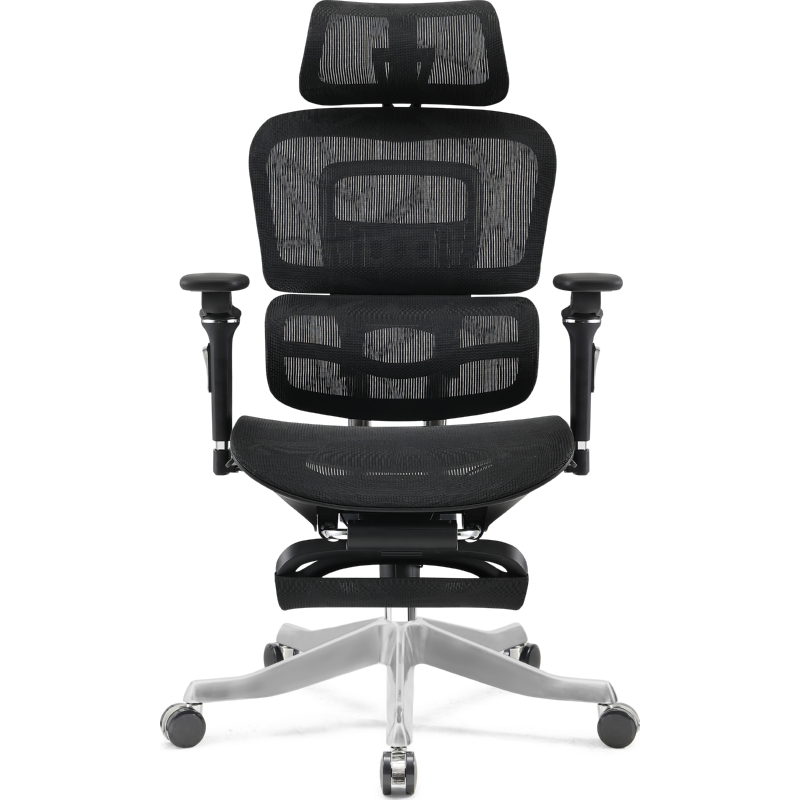How an Ergonomic Office Chair provides maximum comfort while working
Discover the Important Attributes of an Ergonomic Office Chair That You Should Consider
Picking the ideal ergonomic office chair is important for any individual spending lengthy hours at a workdesk. Key features such as adjustable seat elevation, lumbar assistance, and armrest adjustability can substantially impact comfort and pose. Ergonomic Office Chair. Comprehending the relevance of seat deepness and material high quality also plays a basic role in general fulfillment. Nevertheless, many neglect other vital elements. What additional variables should be taken into consideration to ensure peak performance and wellness in the office?
Flexible Seat Height
When picking an ergonomic workplace chair, adjustable seat height is a crucial function that considerably enhances convenience and usability. This particular allows users to tailor the chair's elevation to their individual requirements, guaranteeing that their feet rest flat on the flooring while their knees continue to be at a 90-degree angle. Correct seat height adds to excellent pose, reducing pressure on the legs and reduced back throughout prolonged durations of sitting.
In addition, adjustable seat elevation accommodates a diverse variety of type of body and desk arrangements, making it a flexible choice for both home and workplace setups. The simplicity of change normally involves an easy lever device, permitting customers to modify the elevation with minimal effort. This function is specifically beneficial in shared work spaces, where multiple people may utilize the exact same chair. Inevitably, investing in an ergonomic office chair with adjustable seat elevation is crucial for promoting total health and efficiency in the work environment.
Lumbar Assistance
Lumbar support is an important attribute in ergonomic office chairs, as it assists preserve the all-natural curve of the spinal column and lowers the danger of pain in the back. Flexible lumbar support allows users to customize the degree of assistance according to their specific needs, advertising much better posture throughout the day. This adaptability not just enhances convenience however additionally adds to total performance and well-being.
Relevance of Lumbar Support
Correct back support is important for keeping a healthy and balanced posture during lengthy hours of resting. The lumbar area of the back is normally bent, and without appropriate support, this curve can flatten, bring about discomfort and stress. Not enough lumbar assistance can cause a range of problems, including reduced neck and back pain, muscular tissue exhaustion, and reduced performance. When an office chair provides proper back assistance, it assists to align the back, minimizing the possibility of establishing bone and joint disorders. This support encourages the user to unwind in the chair, promoting interaction of the core muscles and boosting general comfort. Selecting an ergonomic chair with proper back assistance is crucial for individuals who spend extended durations at their desks.
Flexible Lumbar Characteristics
Flexible lumbar features are important in improving the effectiveness of office chairs created for long term resting. These features enable customers to tailor the elevation, depth, and firmness of the lumbar support to line up with their one-of-a-kind spine contours. Appropriate back assistance alleviates pain and advertises healthy and balanced pose, decreasing the risk of back pain associated with extensive desk work. When selecting a workplace chair, it is essential to seek options that provide simple changes, allowing individuals to locate their finest support level. Furthermore, some chairs come with memory foam or breathable products, enhancing comfort throughout long hours. On the whole, adjustable lumbar attributes substantially add to a much more ergonomic office, cultivating performance and health amongst users.
Seat Deepness and Width
Seat deepness and width are necessary consider identifying the general convenience of an ergonomic office chair. Correct dimensions can greatly influence a person's position, making adjustability vital for suiting numerous physique. Guaranteeing excellent seat measurements enables individuals to maintain a healthy seats setting throughout their workday.
Ideal Seat Dimensions

Finding the best balance in seat measurements is vital for comfort and assistance in an ergonomic office chair. An ideal seat size commonly ranges from 18 to 22 inches, suiting various type of body while preserving ease of motion. Seat deepness is equally essential, with a suggested depth of 16 to 18 inches, enabling customers to rest pleasantly without feeling limited. Appropriate seat dimensions ensure that the thighs are adequately sustained while leaving a tiny gap between the rear of the knees and the seat side, promoting circulation. Additionally, the seat must allow users to maintain a natural position, reducing the risk of strain. On the whole, choosing the appropriate seat dimensions is critical for enhancing productivity and health during lengthy hours of resting.

Adjustability for Convenience
While convenience is paramount in an ergonomic workplace chair, the ability to readjust seat deepness and width plays a crucial role in fitting specific choices and body kinds. Seat deepness adjustments allow users to position themselves efficiently, ensuring that their backs are supported while giving appropriate area for their legs. A seat that is too deep might bring about pain at the knees, while one that is also superficial can cause inadequate Click Here assistance. In a similar way, flexible seat size aids deal with different body sizes, advertising a more individualized seating experience. By allowing individuals to modify these measurements, ergonomic chairs improve total convenience, allowing longer, more productive job sessions without unnecessary stress.
Effect on Stance
Appropriate seat deepness and width significantly affect stance, as they straight impact how a customer aligns their body while seated. An ideal seat deepness allows the upper legs to relax completely on the chair without too much stress at the rear of the knees, promoting circulation and convenience. If the seat is too deep, it can bring about slouching, her comment is here while a seat that is as well superficial might not offer ample assistance. The size of the seat should fit the individual conveniently, permitting for natural arm placing without restriction. A chair that sustains a neutral spinal column position urges far better pose, minimizing pressure on the back and neck. As a result, choosing the right seat measurements is important for maintaining healthy and balanced pose throughout extended sitting.
Armrest Adjustability
Armrest adjustability plays an essential duty in boosting user comfort and support during long term durations of sitting. Ergonomic office chairs commonly feature armrests that can be relocated different directions-- up and down, side to side, and even rotated. This versatility allows individuals to find the perfect height and angle, minimizing stress on the shoulders and neck. Appropriate armrest positioning can likewise minimize pressure on the wrists, advertising better hand placing when typing or utilizing a mouse. Additionally, flexible armrests fit various type of body and personal preferences, making sure that each individual can accomplish a personalized fit. Fixed armrests may bring about discomfort and exhaustion, especially during expanded usage, whereas adjustable choices give the adaptability required for dynamic workplace. Consequently, when selecting an ergonomic office chair, considering armrest adjustability is important for overall comfort and performance at job.

Backrest Recline and Turn
Backrest recline and tilt features significantly add to an ergonomic workplace chair's general support and comfort (Ergonomic Office Chair). These devices enable customers to readjust the angle of the back-rest, giving suitable back alignment and reducing stress on the lower back. A chair with a proper recline function enables people to shift their stance throughout the day, advertising much better blood circulation and minimizing fatigue
Furthermore, the tilt function encourages dynamic movement, permitting customers to involve their core muscles while seated. This adaptability is vital for maintaining emphasis and performance throughout lengthy hours of job. Chairs that offer a wide variety of recline angles accommodate numerous preferences, fitting both upright seats for tasks and a much more unwinded placement for breaks.
Material and Develop Quality
The selection of material and develop top quality is crucial in establishing the long life and comfort of an ergonomic workplace chair. High-quality materials, such as breathable mesh or durable fabric, improve ventilation, supplying a comfy seating experience during lengthy hours of usage. The structure ought to ideally be constructed from robust products like steel or enhanced plastic, ensuring stability and assistance.
Furthermore, the quality of foam used in cushioning significantly influences convenience levels; memory foam adapts to body contours, providing customized assistance while lowering pressure factors. An ergonomic chair needs to likewise feature a well-designed framework that enables modifications, making sure that customers can personalize the fit to their specific needs.
The build top quality should consist of sturdy wheels and a trustworthy gas lift device for smooth elevation adjustments. Purchasing a chair with exceptional products and develop quality inevitably adds to better pose, efficiency, and overall well-being in the office.
Regularly Asked Concerns
How Do I Pick the Right Chair for My Type Of Body?
To choose the ideal chair for one's body kind, one need to analyze seat height, back assistance, seat depth, and armrest positioning. Checking numerous versions warranties comfort and proper alignment, eventually promoting far better position and health and wellness.
Are Ergonomic Chairs Appropriate for Tall or short Individuals?
Ergonomic chairs can be appropriate for both brief and high individuals, provided they supply adjustable functions such as seat height, backrest, and armrests. This flexibility assurances comfort and assistance for different physique and sizes.
Can I Use an Ergonomic Chair With a Standing Desk?
Yes, an ergonomic chair can be used with a standing desk. It offers versatility for rotating in between standing and resting, advertising far better pose and convenience throughout the day, eventually improving performance and decreasing fatigue.
How Frequently Should I Adjust My Chair Setups?
Changing chair setups must happen consistently, ideally every couple of hours or when experiencing pain. Frequent changes advertise far better stance and convenience, enhancing performance and decreasing pressure during long term periods of sitting. Consistency is key for excellent ergonomics.
What Is the Typical Life Expectancy of an Ergonomic Office Chair?
The ordinary next page life-span of an ergonomic office chair typically ranges from 7 to 10 years, relying on usage, materials, and maintenance. Normal care can extend its long life, making sure suitable support and comfort throughout its life.
When choosing an ergonomic workplace chair, flexible seat elevation is a crucial attribute that significantly boosts convenience and usability. Seat depth and width are essential variables in figuring out the general convenience of an ergonomic workplace chair. Discovering the right balance in seat measurements is essential for comfort and support in an ergonomic workplace chair. While comfort is vital in an ergonomic workplace chair, the capability to readjust seat deepness and width plays an important duty in suiting individual preferences and body types. To pick the right chair for one's body type, one must examine seat height, lumbar support, seat deepness, and armrest positioning.